Categories:
-
3d 96 articles
-
animations 16 articles
-
architecture 47 articles
-
blender 98 articles
-
bédé 19 articles
-
techdrawing 24 articles
-
freecad 191 articles
-
gaming 1 articles
-
idsampa 8 articles
-
inthepress 8 articles
-
linux 57 articles
-
music 1 articles
-
nativeifc 32 articles
-
opensource 268 articles
-
orange 4 articles
-
photo 16 articles
-
projects 35 articles
-
receitas 176 articles
-
saopaulo 18 articles
-
sketches 163 articles
-
talks 25 articles
-
techdrawing 24 articles
-
textes 7 articles
-
trilhas 3 articles
-
urbanoids 1 articles
-
video 47 articles
-
webdesign 7 articles
-
works 151 articles
Archives:
-
2007 22 articles
-
2008 32 articles
-
2009 66 articles
-
2010 74 articles
-
2011 74 articles
-
2012 47 articles
-
2013 31 articles
-
2014 38 articles
-
2015 28 articles
-
2016 36 articles
-
2017 41 articles
-
2018 46 articles
-
2019 59 articles
-
2020 18 articles
-
2021 20 articles
-
2022 7 articles
-
2023 25 articles
-
2024 15 articles
-
2025 1 articles
Casa Min-Max

Esta casa custa R$ 55 000. Completa, com tudo.
This house costs BRL 55 000. Complete, with everything.
Como chegamos ate aqui?
Sempre nos incomodou o conceito de habitação "social". Como se habitação pura fosse outra coisa, como se a habitação "social" fosse uma exceção e não a regra (falamos em Brasil). Mas o que os livros chamam de habitação social é onde vive a maioria das pessoas. Então por que dar um nome especial ao que é o corriqueiro? Pois bem, daqui em diante trataremos apenas de habitação. Como deve ser. Digna e para todos.
How did we get here?
The concept of "social housing" always disturbed us. As if "pure" housing was something else, as if social housing was an exception to the rule (we are mainly talking about Brazil here). But what books call social housing is actually where most of the people live. Why give a special name to something that is common? From now on, we will only talk about housing. As it should be. Dignified and for anybody.

Este é uma reflexão nossa sobre o conceito de casa incremental, usado pelo arquiteto chileno Alejandro Aravena, que pode ser resumido assim: “Com um orçamento pela metade, em vez de fazer uma casa meio boa meio ruim, vamos fazer uma meia-casa boa, onde o morador possa completar a outra metade depoisâ€?.
Essa é a nossa jornada. Enquanto arquitetos e enquanto moradores. Enquanto pessoas que desejam uma cidade com oportunidades mais igualitárias para todos. Esse projeto foi feito para ser uma experiência real. Não apenas um projeto, mas como ele se comporta no dia a dia. O mais importante para isso é saber: quanto custa para fazer o que queremos e precisamos?
Qual o máximo que podemos fazer com um mínimo de custo? Quais seriam as soluções mais adaptadas aos financiamentos existentes? Encontrar o equilíbrio. Iniciar pelo orçamento.
This is a reflection about the incremental housing concept, used by Chilean architect Alejandro Aravena, that can be explained like this: "With half a budget, instead of doing a house that is half-good, half-bad, let's do half a good house, where the owner can do the other half later".
This is our journey. As architects and as dwellers. As people who want a city with more equal opportunities for eveybody. This project was thought to be a real experience. Not only as a project, but how it behaves day after day. The most important question for this to become real is: How much does it cost to do it the way we want?
What is the maximum we can do with a minimal cost? What are the solutions most adapted to existing financing options? Find the equilibrium. Begin from the budget.
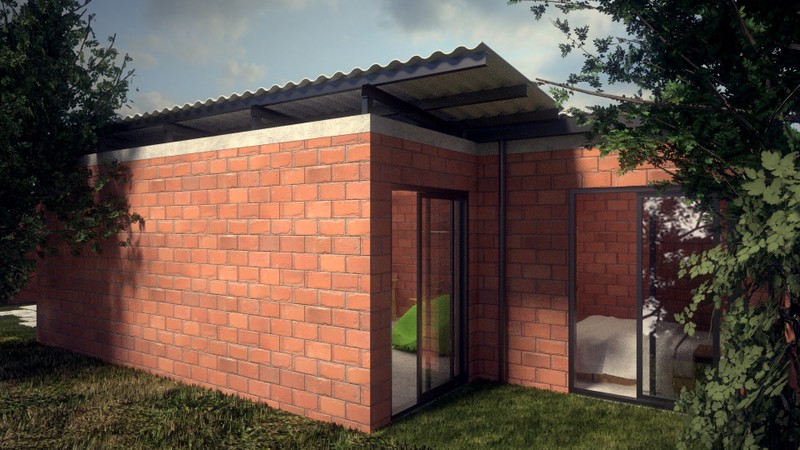
Casa max-min
Nossa busca foi por uma solução urbana, pratica e de qualidade, que pudesse ser executada facilmente e que permitisse reduzir os custos iniciais para facilitar o financiamento. Partimos de duas ideias inspiradas pelo Aravena para montar o nosso projeto de meia casa "boa" e economizar custos:
- A casa pode ser aumentada
- Parte do acabamento é feita posteriormente
Esse projeto é um projeto piloto. Ele foi desenvolvido para ser o ponto de partida para outras ideias, ser adaptado caso a caso, terreno a terreno, família a família. É uma casa pensada para cidades, onde o terreno é caro.
Decidimos por utilizar um terreno de 70 m², que é pequeno, mas é um tamanho bem comum nos bairros mais periféricos de São Paulo e nas áreas que eram favelas antigamente. Podemos utilizar posteriormente terrenos maiores ou menores, mas construir em um terreno menor permite, em ultimo caso, um maior investimento no mesmo. Isso significa poder utilizar um terreno mais valorizado, com mais acesso aos equipamentos e facilidades urbanas. É importante lembrar que morar bem é feito 50% pela casa propriamente dita e 50% do local onde se mora.
Essa casa não é uma casa de interesse social, é uma casa para todos aqueles que estejam interessados em construir com qualidade economizando muito e estejam dispostos a fazer algumas concessões.
Ela tem, a princípio, 50m². Consideramos 50m² um bom custo-benefício, o que é muito relativo: para alguns pode ser pouco, mas muitas habitações são muito menores. O PMCMV (Programa Minha Casa Minha Vida) tinha como mínimo 41 m², mas muitos empreendimentos no centro da cidade de São Paulo possuem muito menos, mesmo os idealizados para pessoas de alta renda (na região central, uma construtora conhecida está, neste momento, vendendo apartamentos de 18m²).
Max-min house
Our search is for a urban, practical and quality solution, that can be easily executed and that allow to reduce the initial costs to facilitate the financing. We started from two ideas inspired by Aravena to build our "half a good house" project and reduce costs:
- The house can be expanded
- Part of the finishing can be done later
This is a pilot project. It is developed to be the starting point for other ideas, be adapted case by case, terrain by terrain, family by family. It is a house designed for cities, where the price of the land is high.
We started using a 70 m² terrain, which is small, but a very common size in peripheral neighbourhoods of São Paulo and areas that were favelas (slums) before. It is of course possible to use bigger terrains (or smaller), but using a small terrain gives a better investment. This means that it is possible to use a better terrain, more expensive, but localised closer to urban equipment and facilities like schools, shops, jobs, etc. It is important to keep in mind that "a good house" depends half on the house itself, half on where this house is situated.
This house is not social housing, it is a house for anybody interested in building something with quality, for a cheap price, and ready to make some concessions.
It has, in principle, 50 m². We consider 50 m² as a good quality-cost balance, which is of course very relative: For some it can feel small, but many housing units are much smaller. The PMCMV (Programa Minha Casa Minha Vida) program specified a minimum of 41 m², but many housing units in the centre of São Paulo have much less, even when targeting people with high income (in the central region, a known real-estate company is currently selling 18 m² units).
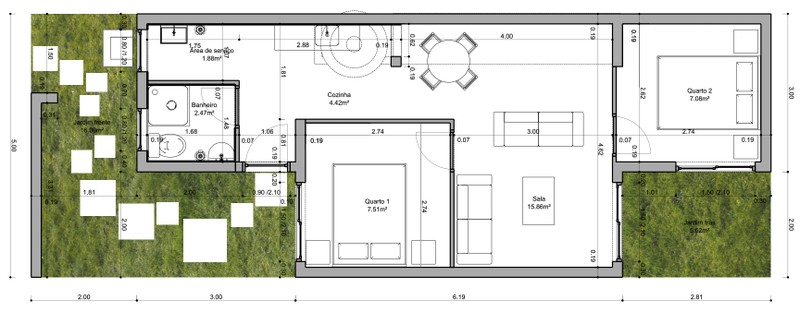
Um dos quartos pode abrir diretamente para o espaço exterior da frente, o que permite usar ele para trabalho (escritório, consultório, oficina, etc). A possibilidade de trabalhar em casa ajuda a reunir trabalho e moradia, que em cidades grandes ficam muito distantes um do outro, além de ampliar as opções de vida dos moradores.
O projeto inclui fundações já calculadas para que no futuro possua um andar superior, o que pode aumentá-lo para até 100m². Para isso, a laje já é recortada para a escada. A cobertura é desmontável e pode ser reaproveitada em cima do andar superior quando o mesmo for construído.
One of the rooms can open directly to the front yard, which allows to use it to work (as an office, consultancy cabinet, workshop, etc). This also helps to reunite working and living, which is big cities have become very distant one to the other. This also helps to give more life options to people living in the house.
The project has foundations already dimensioned to bear a future upper floor, which can raise the floor area up to 100m². The above slab is also already cut to allow the placing of a staircase. The roof is removable and can be reused above the upper floor when it gets built.
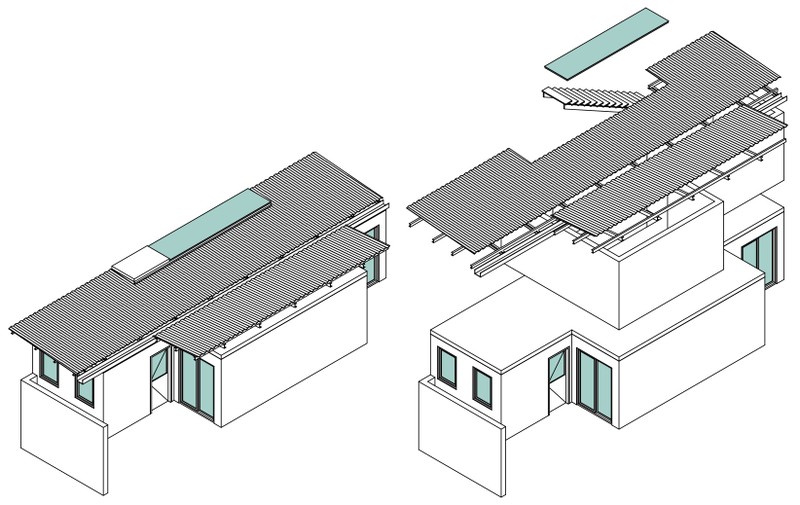
A cobertura também é descolada da laje, com ampla ventilação, para não transmitir o calor, melhorando o isolamento térmico.
The roof is also separated from the slab, with good ventilation, to not transmit the heat, which is the best possible thermal insulation.
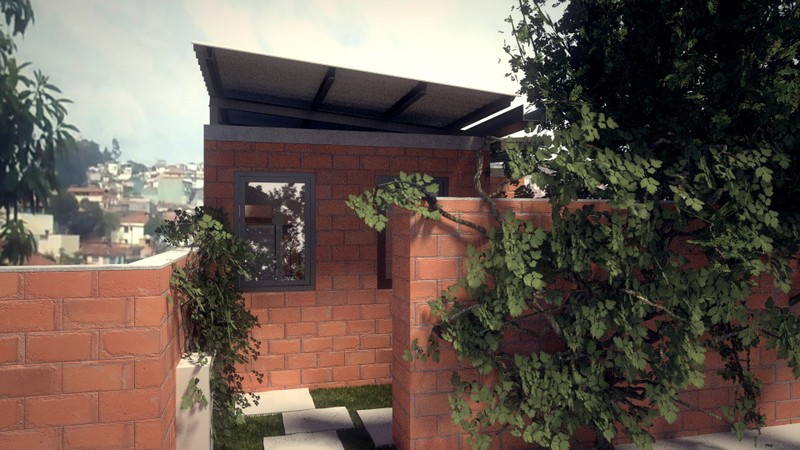
Começamos o projeto dessa casa pelo orçamento, o qual pretendemos que esteja em constante evolução. Ela custa, em sua versão mínima porem completamente habitável, menos de R$ 55 000. Em conjunto com os arquivos de desenho do projeto, estamos disponibilizando um arquivo com a tabela do orçamento. Usamos como fonte o SINAPI, os preços da PMSP, do FDE-SP e outras fontes publicas, discriminadas a cada item. Todos esses campos podem ser trocados, permitindo que cada um pegue essa listagem em sua cidade e consiga saber quanto que uma casa como essa poderia custar. Para chegarmos a esse preço, usamos os preços mais altos que encontramos, o que significa que provavelmente ela custara menos que isso, mas queríamos evitar surpresas desagradáveis.
Com R$ 55 000, ela tem tudo que normalmente é entregue em uma casa nova: Infraestrutura, encanamento, equipamentos, instalação elétrica boa, etc. Tem muitas janelas, pois o aumento de custo é pouco. Assim, apesar do terreno pequeno, a luz é captada por todo lugar, por onde for possível. Também toda a parte mais cara para a construção do segundo andar já esta incluída: as fundações, as lajes e o local da escada.
Como falamos anteriormente, para economizar, nessa versão deixamos algumas partes para serem feitas posteriormente. As paredes em geral não possuem acabamento. Apenas na cozinha, área de serviço e banheiro foi previsto acabamento cerâmico. Isso economiza mais de R$ 5000. O acabamento pode ser feito depois, mas também pode ser deixado assim. Foi pensado para funcionar muito bem sem qualquer acabamento.
We began the project with the budget scheduling, which should stay in constant evolution. The house costs, in its minimal but fully habitable version, less than 55 000 BRL. Together with the design files, we are providing the full budget estimation spreadsheet. We used several public sources like SINAPI, and prices from PMSP and FDE-SP, which are indicated in the spreadsheet. All these prices can be revised and changed, allowing anyone to adapt the prices to what is available in his/her city and know precisely how much it will cost. In this estimation, we also used systematically the highest prices available, to avoid bad surprises later. So this house might cost less than that.
With 55 000 BRL, it has everything that is commonly included in a new house: Infrastructure, piping, equipment, good electrical installation, etc. There are large windows, which don't raise the price much. Therefore, even on a small terrain, light can enter everywhere, wherever possible. All the more expensive part of the possible upper floor is already included: Foundations, slabs, and the place for the stairs.
As we wrote earlier, to save money, in this version, some parts are left to be done later. Most of the walls don't have finishing. Only the kitchen, service area and bathroom have ceramics on the walls. This saves more than 5 000 BRL. Finishing can be dome later, but it can also be left as is. The project is thought to work without the need for any finishing.

Uma outra grande economia possível, em vez de construir uma casa só, é construir mais de uma, e dessa maneira, compartilhar uma das paredes laterais com um vizinho.
Ela pode ser construída com blocos de concreto ou cerâmicos. O preço é quase o mesmo e as propriedades, similares. O bloco cerâmico respira melhor, o que melhora a atmosfera dentro da casa. Existem também outras possibilidades que ainda não exploramos, como o tijolo de solo-cimento.
O valor da casa sem economia nenhuma é R$ 67 000. Mas também é possível diminuir o preço bem abaixo de R$ 55 000, por exemplo fazendo algumas partes si mesmo, economizando mão de obra. Não é nenhuma tarefa impossível, existem muitas maneiras de aprender.
Caso seja construída com construtora, o valor ficara bem mais alto por causa dos custos indiretos da construtora, como transporte, funcionários, mestre de obra, etc, e que incluem também o lucro da empresa. Essas despesas indiretas hoje em dia podem chegar em torno de 30% do valor da obra.
Esse projeto é totalmente open source. Todos os arquivos podem ser baixados, usados e modificados por quem quiser. Mas também permite que outras pessoas tragam ideias e que o projeto melhore. Sinta-se a vontade para agregar e discutir.
Another possible big saving is, instead of building a single house, to build more than one next to each other, so one of the side walls can be shared with a neighbour.
It could be built with concrete blocks or ceramic masonry. The price is almost the same and the properties are similar. The ceramic masonry breathes better, which betters the atmosphere inside the house. There are more possibilities we didn't explore yet, such as cement-earth blocks.
The price of the house without any of these savings is 67 000 BRL. But it is also possible to lower the price well below 55 000 BRL, for example by self-building some parts, which saves labour costs. This is by no means an impossible task, many ways to learn exist.
If this is house is given to a construction company to build, the cost will be much higher, because of the indirect costs of the company like transport, employees, etc and the profit of the company itself. These indirect costs can today add around 30% to the building costs.
This project is fully open source. All the project files can be downloaded, used and modified by anyone. But it also allows other people to bring ideas and make the project better. Feel at home to join and discuss.
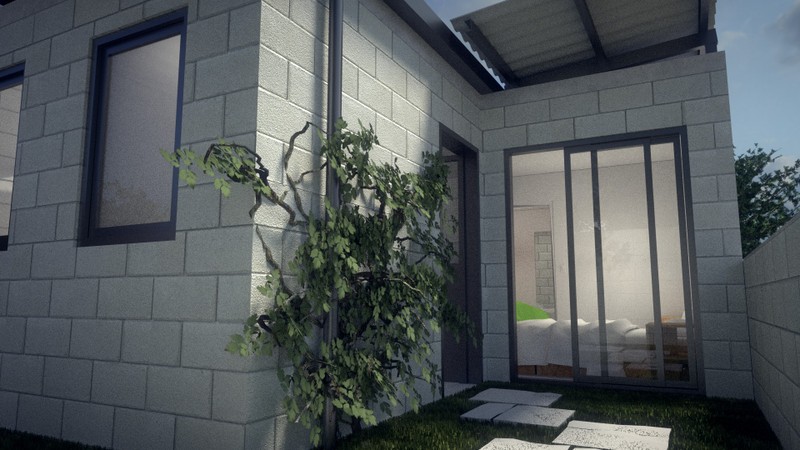
Veja mais:
See more: